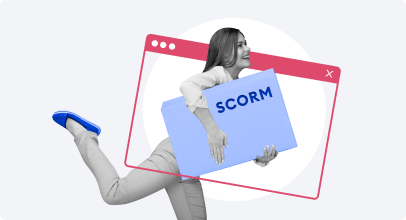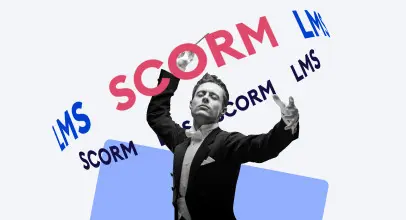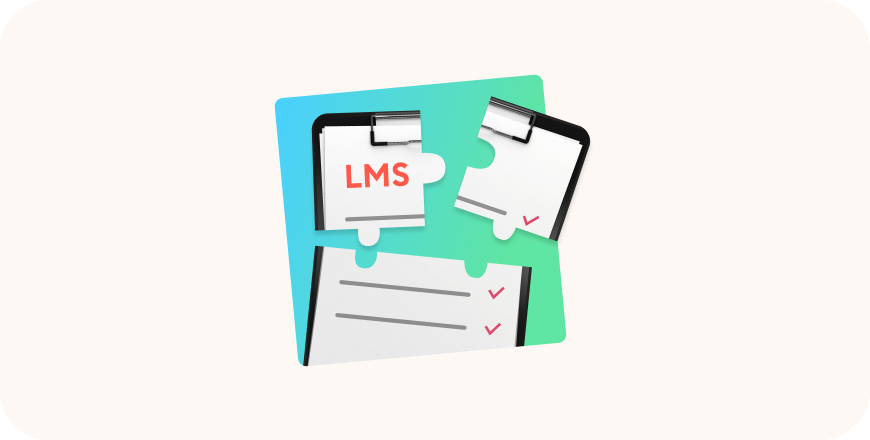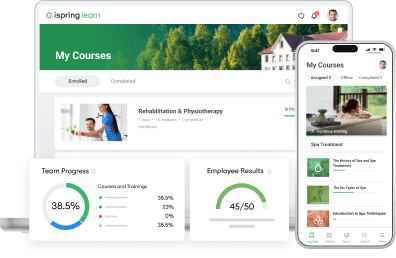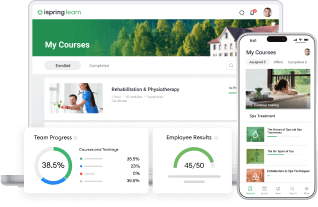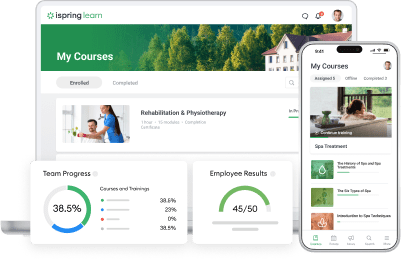What’s The Best SCORM-Compliant LMS in 2025?

Here you are, ready to deliver your online courses to learners. You’re likely to know you need a SCORM-compliant learning management system (LMS), but which platform is the best fit? And what does SCORM-compliant mean?
While eLearning authoring tools help create SCORM-compliant content, SCORM-compliant learning management systems provide the platform to deliver and manage this content. In this blog post, we’ll guide you through some SCORM technical refinements and provide you with guidance on making a smart choice in a SCORM-compliant LMS. We’ll also provide a quick overview of the best SCORM-compliant learning management systems for corporate eLearning to make your selection process easier.
SCORM Explained
SCORM stands for The Sharable Content Object Reference Model. It is a set of standards for eLearning software. Thanks to this, an LMS runs any SCORM course just like a DVD player will play any DVD disc. So, if a company uses this format and decides to switch to another online learning platform, there’s no need to worry about losing any training content, as any other SCORM-compliant LMS will recognize it too.
Also read → 21 Best SCORM Authoring Tools and Other SCORM Software
What Is a SCORM-Compliant LMS?
A SCORM-compliant LMS is an online platform that adheres to SCORM standards. There are three levels of SCORM compliance:
- SCORM-compliant
- SCORM-conformant
- or SCORM-certified
The difference lies in the number of CMI elements supported, which are commands the SCORM-compliant learning management software can follow and the types of data it collects.

Three levels of SCORM compliance
Generally, a SCORM-compliant LMS supports basic interaction between courses and the platform, including commands for communication initialization, progress saving, and completion. These solutions meet the needs of most users.
What is “SCORM-conformant”?
SCORM-conformant learning management systems support a wider set of CMI elements, allowing a more detailed analysis of the data gathered. For example, assessments published in SCORM 1.2/2004 allow you to obtain detailed question-answer level results. At the same time, not all learning management systems enable this level of support, but this doesn’t mean that they are non-compliant.
Both conformant and compliant mean that an online learning management system supports SCORM standards. It wasn’t confirmed by a third-party certification, but the vendor has most likely performed its own tests.
What is “SCORM-certified”?
SCORM-certified LMS software provides you with the maximum level of SCORM support and aligns with the industry standard. Their compliance is verified by Advanced Distributed Learning (ADL), a third-party organization. Its engineers use special testing tools that allow them to check almost every possible use case for an eLearning course.
The 5 Best SCORM-Compliant LMSs
With so many online learning platforms available in the eLearning industry, it might be difficult to choose between appropriate SCORM-compliant LMSs. To make life easier for you, we’ve prepared a short list of the best SCORM-compliant learning management systems.
Have a look at this comparison chart of the best corporate LMSs for a quick overview. Read on to get the details about each platform.
Before presenting you with the entire list of the best SCORM-compliant platforms, we’d like to focus your attention on the three we liked the most.
iSpring Learn
A reliable SCORM LMS to onboard, upskill, and certify your teams.
Skilljar
A robust LMS that helps businesses train everyone they deal with.
Litmos
A handy LMS for companies that prioritize employee training and development.
SCORM support: SCORM 1.2; SCORM 2004
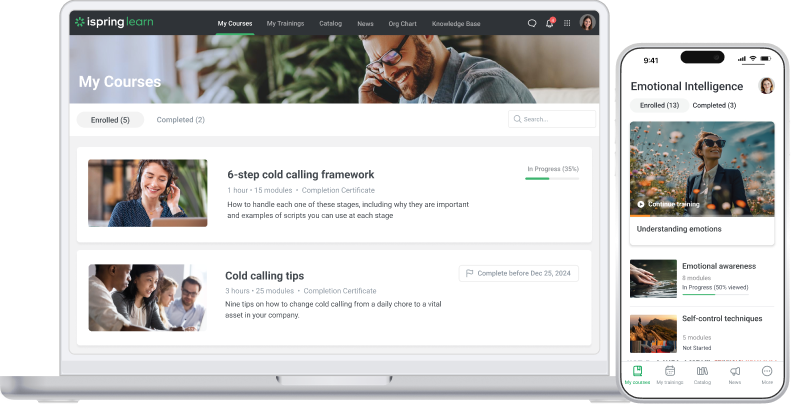
iSpring Learn is a single training solution for companies of any size, from small and medium businesses to an extended enterprise. It’s an intuitive LMS that has everything you need to train employees effectively and make a business impact: support of various kinds of SCORM-compliant content, learning modules that can be grouped into personalized learning paths, automated training distribution, strong analytics, gamification features, social learning, localization features, and more — all in one system. It’s perfectly suited for various types of learning programs, including blended learning as it also lets you host virtual classes and track the attendance of classroom training.
But its main benefit is that it allows you to go beyond content delivery to achieve training success. For example, with its built-in eLearning course creation tool, you can create SCORM-compliant courses and quizzes in a snap. With a built-in newsfeed, you can keep all employees up to date on company news and product releases. And with the 360-degree performance appraisal module, you can always have a clear picture of your employees’ competencies. All features are easy to use thanks to an extremely intuitive user interface.
Also, the LMS integrates with iSpring Suite, a powerful authoring tool that allows you to design your own SCORM-compliant courses with advanced quizzes, interactions, role-play simulations, and video tutorials.
Take a look at this demo course created with iSpring Suite:
Outstanding features:
- A built-in tool with an AI Assistant for creating SCORM-compliant courses and quizzes
- Integrated authoring tool for building versatile SCORM-compliant learning content
- Supervisor dashboard
- Social learning features (a newsfeed, learner cards, interactive organization chart, gamification, leaderboards, etc.)
- 360-degree feedback assessment
- Observation checklists for on-the-job training
- Integration with Zoom, MS Teams, Salesforce, Bitrix24, BambooHR, PeopleWeek, Shopify, Udemy, LinkedIn Learning, and other popular services
- A library of ready-made courses
- A native mobile app
Pricing: Pricing plans vary based on the total number of users, starting at $6.64 per user/month for a total of 100 active users.
Get a free trial of iSpring Learn →
SCORM support: SCORM 1.2; SCORM 2004
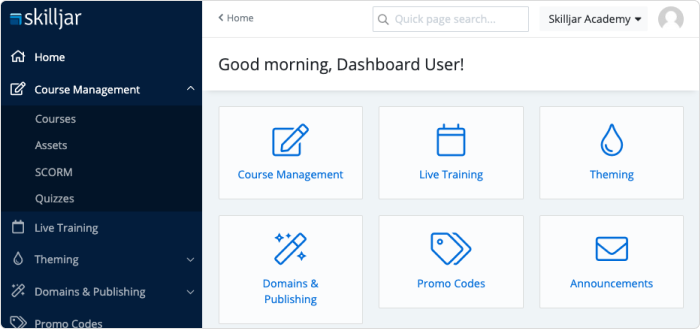
Skilljar is a SCORM-compliant LMS that helps businesses train everyone they deal with, including their customers and partners. It provides you with all eLearning tools you need to onboard, engage, and retain customers and partners at scale. It supports different types of learning content, SCORM, and AICC packages as well. This LMS also allows you to assess learners by creating quizzes right on the platform and issuing certificates after they complete a training.
Outstanding features:
- Personalized learning paths
- Automatic progress tracking and insightful analytics
- A built-in tool for creating SCORM-compliant quizzes
- Instructor-led training due to integration with Zoom and Webex
- Certificates and certifications
- Integration with Salesforce for selling SCORM-compliant online courses
- Fully mobile responsive and brandable
Pricing: Available upon request.
SCORM support: SCORM 1.2; SCORM 2004
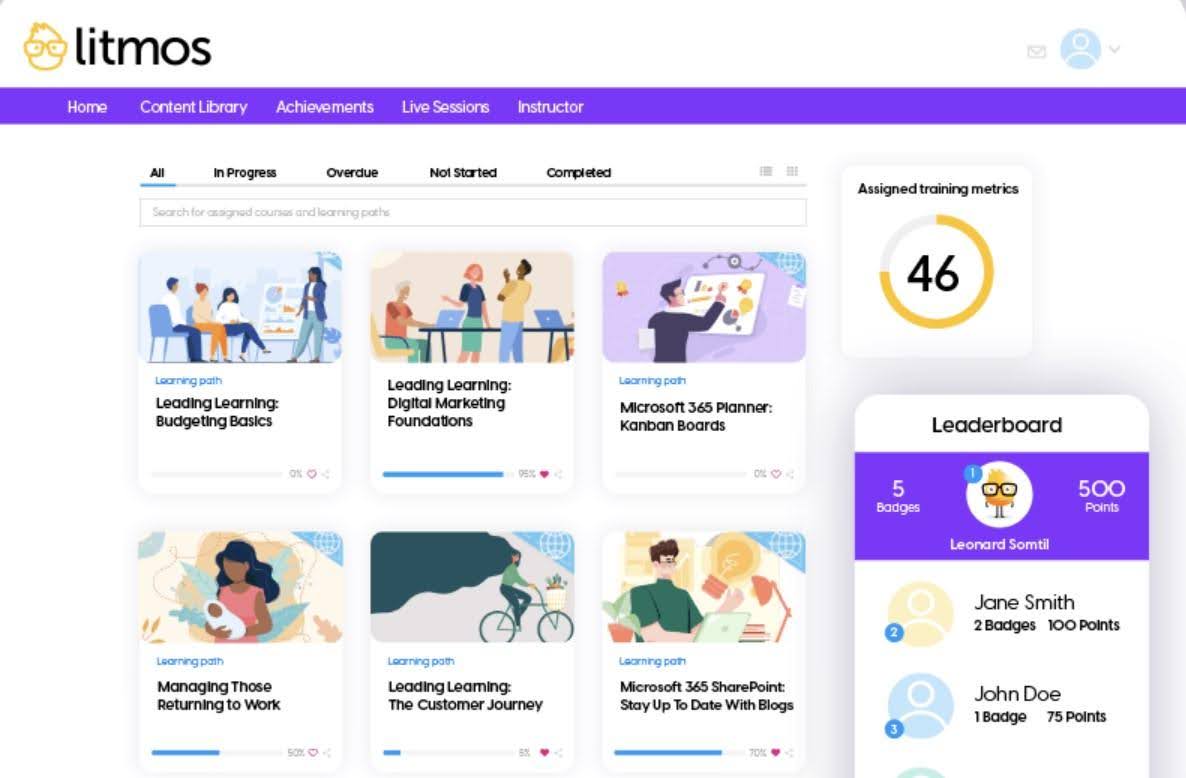
Litmos is a handy SCORM-compliant LMS for companies that prioritize employee training and development. It has all essential features, allows you to create learning modules from internal training materials and your own courses right on the platform and offers a large library of off-the-shelf SCORM-compliant courses for compliance training, leadership training, soft skills development, and more. With Litmos, you can easily integrate with the rest of your ecosystem by choosing out-of-the-box connectors or by building your own with open APIs.
Outstanding features:
- A built-in drag-and-drop content authoring tool
- Engagement tools (gamification, certificates, leaderboards, interactive hotspots, social sharing, and discussion forums)
- Gen AI learning assistant
- A tool for creating AI video assessments
- A library of over 80,000 SCORM-compliant off-the-shelf training courses
- Instructor-led training (ILT/vILT)
- Integration with HRIS, CRM, Experience Cloud, Shopify, MS Teams, and more
Pricing: Available upon request.
SCORM support: SCORM 1.2; SCORM 2004
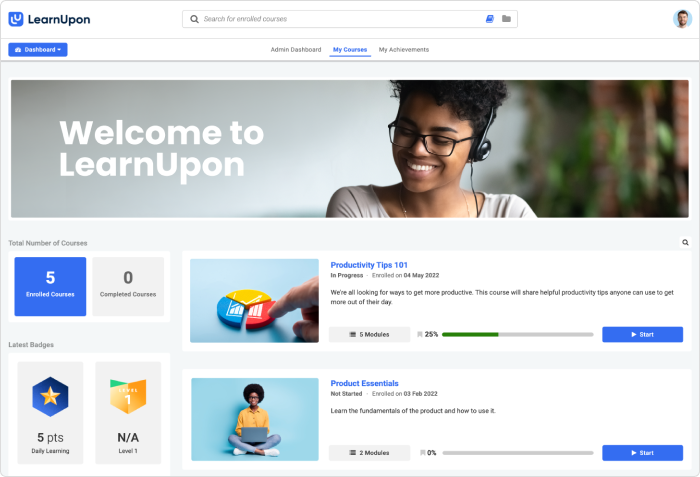
LearnUpon is another SCORM-compliant LMS that boasts rich functionality in a single system. In addition to the common features, like delivering eLearning courses and tracking learners’ results, you can also create online storefronts to sell your eLearning content. But its most distinctive feature is its “learning portals,” or in other words, multiple LMSs that you can create for training different audiences, but all controlled in one place.
Outstanding features:
- AI-powered tools for creating SCORM-compliant courses and assessments
- A robust reporting and analytics dashboard
- Custom learning portals for separate audiences (multitenancy)
- Course credits and certificates
- A learner-facing mobile app
- Interactive smart coach that can be used as a personal guide
- Integration with a wide range of services
Pricing: Available upon request.
SCORM support: SCORM 1.2; SCORM 2004
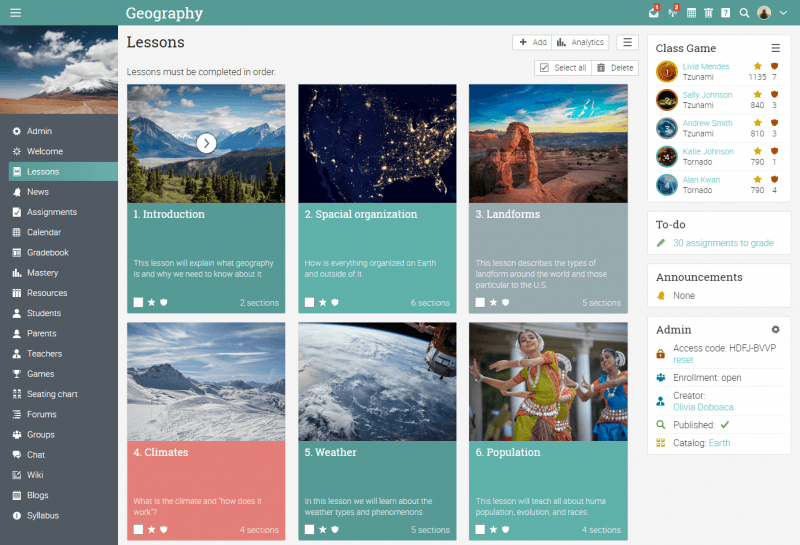
CYPHER Learning is an AI-powered platform that revolutionizes how SCORM-compliant educational content is created, delivered, and managed. It combines a Learning Management System (LMS), a Learning Experience Platform (LXP), and SCORM authoring tools into a single platform. CYPHER adapts to the needs of businesses and academic institutions of any size, making learning accessible and cost-effective. The platform supports a variety of content formats and offers extensive customization options, including white labeling.
Outstanding features:
- A built-in SCORM-compliant authoring tool and integration with LTI-based educational tools
- An AI-powered tool for building assessments
- Skills assessment and development tool
- Content recommendation engine
- Real-time analytics and reports
- Customization and branding
- Certificates and certifications
Pricing: Available upon request.
How to Choose a SCORM-Compliant LMS
If you want your eLearning courses to run smoothly, it’s essential to ensure that your LMS fully supports SCORM standards. But SCORM compliance isn’t one-size-fits-all — different platforms handle SCORM in different ways.
To help you find the LMS that fits your needs, here are some important questions you should ask.
1. Does the LMS support the right SCORM version for your courses?
Even if an LMS claims to support all versions of SCORM, some may perform better with a specific one. For instance, if your courses are built on SCORM 2004 (3rd edition), you’ll want an LMS that handles this version most efficiently. This can make a big difference in SCORM course performance and learning experiences.
2. Will the LMS track learner progress in a way that works for you?
SCORM tracks user progress through different data elements. Understanding whether the LMS supports key tracking elements (like completion status and test scores) is crucial. Make sure the LMS can capture the learner data that matters most to you.
3. Is the LMS officially certified for SCORM compliance?
A certification from ADL means the LMS has been tested and proven to work with SCORM at an industry standard. If it’s not certified, ask which SCORM features are supported to avoid any surprises later.
4. How easy is it to upload and manage SCORM-compliant content on this LMS?
You want a platform that doesn’t make uploading SCORM-compliant course content a chore. Check if it allows easy uploading of SCORM packages directly from your course creation tool, so you can manage content quickly and effortlessly.
5. Does the LMS come with a reliable SCORM player?
If the LMS doesn’t use the well-known Rustici Engine, ensure it has a built-in player for SCORM-compliant files. Features like a navigation panel and a simple “close” button will improve the learning experiences for learners.
6. Will the LMS record learner data accurately, even during fast navigation?
Learners often move quickly through courses, and if the learning management system can’t keep up, important progress might not get recorded. Look for an LMS that uses a fast, reliable SCORM player (ideally JavaScript-based) to ensure all data is captured.
7. Will users get lost with too many pop-ups and windows?
Some SCORM-compliant learning management systems open learning modules in multiple windows, which can confuse learners and slow down their progress. If an LMS relies heavily on pop-ups, it could affect the user experience — especially during time-sensitive tasks like quizzes.
8. Is the LMS mobile-friendly for learners on the go?
If your learners access courses from their phones, the LMS needs to scale SCORM-compliant content properly. Without mobile optimization, users might struggle with non-adaptive slides, leading to inaccurate tracking of progress in some learning modules or incomplete data.
9. Will you need to install extra plugins to get the LMS working?
A hassle-free LMS should work with modern technologies like HTML5 and JavaScript. If the platform requires additional setups like Flash, Silverlight, or VPNs, it may create unnecessary headaches.
10. Does the LMS offer robust support for troubleshooting?
Even the best systems can run into issues. Knowing how the LMS handles errors, data loss, or other problems is critical. A solid debugging tool can save you time and prevent course disruptions when things go wrong.
FAQ on SCORM
Here are some questions a learning manager or eLearning content creators may have and answers to them.
Are all LMSs SCORM-compliant?
Pretty much. Almost all LMSs support SCORM-compliant content, but there may be exceptions. Some LMS platforms only allow for exporting data in SCORM files, but not importing SCORM packages into the system. However, in most cases, if you have SCORM-compliant content, it will work in your LMS.
What are the most common versions of SCORM?
SCORM 1.2 and SCORM 2004 4th and 3rd Edition are the most widely used versions of SCORM today.
What are the alternatives to SCORM?
SCORM is the predecessor of the newer eLearning standards: xAPI (Experience API, or Tin Can) and сmi5. These formats allow for more convenient work on mobile devices, more responsive design, and provide detailed statistics. Usually, eLearning authoring tools allow you to create courses in several of these formats.
How can I run a SCORM package?
You can open the package in a SCORM-compliant LMS that has a built-in SCORM player or in your web browser. Or you can unzip the files and find the one with your learning materials that might be named something like index.html or story_html5.html.
How do I edit SCORM packages?
If you have a source (project) file of a SCORM course, you can open it with a SCORM- compliant authoring tool and make changes to the eLearning content at any time.
Is it possible to host SCORM packages without a SCORM-compliant LMS?
Yes, it is possible to host SCORM packages without an LMS. You can use a web server or a cloud-based hosting service to upload and serve the SCORM files. However, without an SCORM-compliant LMS, you will not have access to features such as user tracking, reporting, and course management.
The Bottom Line: SCORM and iSpring Learn
As you can see, to make an informed choice of a SCORM-compliant LMS, you’ll have to dive deep into the technical nuts and bolts. If you don’t want to get lost, keep in mind three major questions:
- What versions of SCORM do you use (or plan to use) for your current eLearning content?
- Does your authoring tool really create SCORM-compliant courses?
- What level of SCORM support do you expect from a SCORM-compliant platform?
iSpring Learn is a SCORM-compliant LMS that supports SCORM 1.2 and SCORM 2004. One of its key benefits in terms of SCORM compliance is a fully-integrated authoring tool. It allows you to easily create SCORM-compliant content, upload it right to an LMS in a few clicks, and get extended statistics reports. Feel free to find out how it works by getting a free trial!
